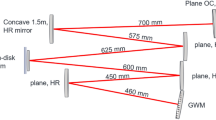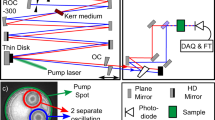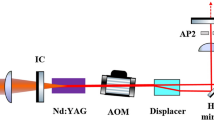Abstract
We report on the first demonstration of an intra-cavity spectral beam combining of two fundamental-mode laser beams generated by a dual Yb:YAG thin-disk resonator. The two thin-disk lasers (TDLs) were operated at the two slightly different wavelengths of 1028 nm and 1032 nm. A resonant diffraction grating waveguide structure was used as common spectral stabilizer and combiner. An average power exceeding 200 W with close to diffraction-limited beam quality ( \(M^2<1.3\) ) was obtained with the presented approach.
Similar content being viewed by others
Avoid common mistakes on your manuscript.
1 Introduction
High-power, high-brightness fiber-coupled solid-state lasers with continuous-wave (CW) emission are required for various applications related to laser material processing such as remote metal sheet cutting and welding [1]. These applications often demand the use of lasers with average output powers in the multi-kW range and high brightness or even diffraction-limited beam quality. These requirements are met by Ytterbium-based fiber and thin-disk lasers [2], which are able to deliver nearly ideal beam properties [3]. To date, near diffracted-limited output beams have been demonstrated with powers of up to 5 kW with a beam propagation factor of \(M^2~\approx ~1.3\) from a single Yb-doped fiber laser [4]. CW fundamental mode laser operation with an average output power up to 4 kW and a beam propagation factor of \(M^2 < 1.2\) was recently reported from a single thin-disk laser [5, 6]. Despite the excellent heat extraction capability of the thin-disk laser architecture, thermally induced wavefront deformations [7] as well as thermally induced natural convection of heated gas in front of the laser crystal [8] represent a limiting factor for the scaling of the average power. In order to increase the power of thin-disk lasers, the radius of the pumped region on the laser crystal has to be increased which furthermore results in a decreasing power range in which the resonator supports stable laser oscillation [9]. Instead of scaling the average power of a single thin-disk laser, the parallel combination of several thin-disk lasers operated at a lower average power is a promising alternative to mitigate the aforementioned thermally induced distortions. The pairing of two different gain materials in a single thin-disk laser resonator was previously reported in a sesam mode-locked thin disk laser experiment achieving a maximum output power of 8.6 W and with a short pulse durations of 124 fs [10]. Beside conventional beam combination techniques [11, 12] that offers alternative solutions to scale the power of lasers while maintaining a good beam quality, a promising approach based on intra-cavity wavelength multiplexing of two fundamental-mode beams generated in two different thin-disk laser resonators is proposed in the present report. The motivation for the choice of the current approach was sustained by the comparatively broad emission spectrum of Yb:YAG and the reduction of the number of required optical elements. With extra-cavity wavelength multiplexing of beams emitted by independent resonators, optical elements for wavelength stabilization are required in each of the resonators in addition of the extra-cavity implementation of a combiner and the adjustment of the axes of the two resonators in order to properly overlay the two beams is very demanding and frail. In our proof-of-principle demonstration, a single resonant diffraction grating waveguide structures (GWS) was implemented [13, 14] as an intra-cavity spectral combiner of the two laser cavities. Using a plane mirror as the common output coupler inherently ensures a collinear superposition of the twos beams. The stabilization of both the wavelengths and the polarization as well as spatial beam combination was achieved using only one GWS. The capability of this type of GWS to withstand average powers of several kilowatts has been demonstrated in a previous study [15]. With the present proof of concept, we report on the spectral combination of two beams with the wavelengths of 1028 nm and 1032 nm yielding a total output power of up to 216 W and a beam propagation factor of \(M^2= 1.25\). This approach is potentially expandable for combining multiple high-power TDLs systems delivering output powers in the multi-kW range with diffraction-limited beam quality[5].
2 Experimental setup
The proposed approach of wavelength multiplexing is illustrated in Fig. 1. It is based on the implementation of a GWS, which provides the spectral combining in the common path of two thin-disk oscillators. The GWS was operated at an angle of incidence slightly off the Littrow condition and consists of a linear sub-wavelength diffraction grating with a period of \(\Lambda\) = 610 nm (\(\approx\) 1640 lines/mm), a groove depth of 205 nm, and a fill-factor (ratio between width of the lines and the period) of 26%.
The choice of the angle of incidence was based on the evaluation of the GWS’s angle-dependent diffraction efficiencies in a spectral bandwidth of \(\Delta \lambda \approx\) 4 nm around the central emission wavelength of 1030 nm of Yb:YAG. The diffraction efficiencies (DE) for TE polarized radiation in the -1st diffraction order were measured to be 99.18 ± 0.1% and 99.17 ± 0.1% at the angles of incidence of 60.04\(^{\circ }\) and 60.73\(^{\circ }\), respectively, by means of a reflectivity measurement according to DIN EN ISO 13697. The spatial limitations required a minimum angular separation of 0.7\(^{\circ }\) of the two incident beams on the GWS. Considering the grating equation, this angular separation corresponds to a wavelength separation of 3.7 nm.
The experimental setup involved two thin-disk laser resonators designed for fundamental-mode operation as illustrated in Fig. 2. The first thin-disk laser resonator (blue) was composed of the following elements: the Yb:YAG thin-disk crystal with a thickness of \(130~\mu\)m, a doping of 9 at.%, and with a radius of curvature (RoC) of 2.1 m, a plane highly reflective (HR) end mirror, a concave HR folding mirror with a RoC of 1.5 m, the GWS and a plane output coupler (OC) with a transmission of 5 ± 1%. The thin-disk crystal had a diameter of 12 mm and was glued on a water-cooled diamond heat sink, which was mounted in a pumping module allowing for 12 reflections of the pump radiation at the laser crystal. The diameter of the pumped area in the disk was set to approximately 3.2 mm. The disk was pumped with a fiber-coupled laser diode delivering up to 484 W centred at a wavelength of 940 nm. The second resonator (red) was built of three plane HR mirrors, a concave HR mirror with a RoC of 1.5 m, the thin-disk laser crystal, and the same optical elements included in the common section of the first resonator namely the GWS and the plane OC. The thin-disk crystal with a thickness of 110 \(\upmu\)m and a doping concentration of 10–11 at.% was also glued on a diamond heat sink and exhibited a RoC of 2.2 m. The fiber-coupled laser diode used to pump this disk was providing a pump power of up to 600 W centred at a wavelength of 938 nm. To enable efficient fundamental-mode operation, the resonators were designed such that the overlap between the diameters of the fundamental mode and the pump beam amounted to 78%. The resonators were setup to oscillate at the two wavelengths of 1028 nm and 1032 nm and designed to produce virtually identical Gaussian beams (same diameter and divergence) in the shared section between the GWS and the OC. This mode matching condition was considered by means of the ABCD-matrix formalism. The two oscillators were accordingly aligned with the help of an external tuneable diode laser. The calculated intra-cavity beam propagation is illustrated in Fig. 3.
3 Experimental results
Each of the two resonators was first characterized individually. The output power, the optical efficiency and the measured beam propagation factor for both TDLs are shown in Figs. 4, 5, and 6, respectively. The maximum available power of 484 W was used to operate the first (blue) resonator centred at a wavelength of 1028.2 nm. The output beam reached a maximum output power of about 154 W and a corresponding beam propagation factor of \(M^2_{x}\) = 1.11 and \(M^2_{y}\)= 1.04 in the horizontal and vertical plane, respectively (see Fig. 5). The second disk laser (red) pumped with a power of 283 W allowed to extract a maximum output power of 62.3 W at a wavelength of 1031.9 nm. The main limitation was due to an observed laser instability caused by the shift of the stability range over which the resonator supports stable oscillation. We believe that this was caused by a stronger thermal lens of the thin-disk that was used in the second resonator, thus shifting this resonator to the edge of its stability range. As a result, the full exploitation of the available pump power of the laser diode was not possible. At this operation point, the optical efficiency was about 22% and the beam propagation factor was measured to be \(M^2_{x}\) = 1.05 and \(M^2_{y}=\) 1.04 as shown in Fig. 6.
The power in the common output beam and the corresponding optical efficiency obtained when the two resonators were coupled by intra-cavity wavelength multiplexing are shown in Figs. 7 and 8. The optical efficiency was defined as the power in the common output beams divided by the total pump power applied to the two thin-disk crystals. Up to 216.3 W of power was measured in the common output beam when pumped with the maximum available pump power of 768 W. At this pump power, the overall optical efficiency was about 28.2% with a slope efficiency amounted to 37%. The output power was distributed with 62.3 W at a wavelength of 1031.9 nm (red) and 154 W at a wavelength of 1028.2 nm (blue). At the maximum output power, the power density on the GWS was approximately \(238~\mathrm{{kW}}/\mathrm{{cm}^{2}}\). The optical and the slope efficiency may be further increased by feeding the 1% of radiation lost to the 0th diffraction orders back into the resonators. This possibility is subject of further investigations and will be reported on at a later date.
The spectral emission was recorded with a spectrometer (Ocean Optics HR series) with a limited resolution of 100 pm. At the total pump power of 565 W, the full-width at half-maximum (FWHM) of the peak centered at the wavelength of 1028 nm was measured to be 266 pm, whereas it was approximately 290 pm at the wavelength of 1032 nm,see Fig. 9. Spectral tuning could in principle be carried to some extent simultaneously for both resonators by a slight lateral displacement and tilt of the OC, however wavelength tuning is beyond the scope of the presented investigation. The beam propagation factor of the combined output beam was measured to be \(M^2_{x}\) = 1.29 and \(M^2_{y}=1.21\) at the output power of 216 W as shown in Fig. 10. The beam propagation factor of the combined beam was slightly degraded when compared to the beam quality of the single beams, which was most likely due to a slight misalignment of the two cavities.
4 Conclusion
In conclusion, we have successfully demonstrated a proof of concept for the intra-cavity wavelength multiplexing of two thin-disk laser oscillators by means of a GWS. An average output power up to 216 W was obtained with an optical efficiency of 28% and a slope efficiency of 37%. The beam propagation factor of the spectrally combined beams was measured to be \(M^{2} <1.3\). Further investigations will be devoted to optimizing the resonators to ensure low degradation of the beam propagation factor of the combined beams. For this purpose, intracavity actively regulated optical elements, such as spherical or aspherical deformable mirror [5, 6], will be implemented to compensate for thermal aberrations. In addition, the pumping scheme of Yb:YAG into the zero-phonon line at 969 nm will be employed in order to reduce the thermal load in the laser crystal [16]. The enhancement of the robustness of the laser system will be considered by means of identical disks in dynamically stable resonators. Moreover, an improved GWS with a diffraction efficiency exceeding 99.9% in a broad bandwidth will be realized for this specific operation conditions to further scale the output power and improve the laser efficiency. Based on the presented demonstration, we believe that the proposed approach can potentially be extended to power scaling of CW thin-disk lasers emitting fundamental transverse mode at \(2~\upmu\)m wavelength.
References
M. F. Zaeh, J. Moesl, J. Musiol, F. Oefele. Physics Procedia. Elsevier B.V., Amsterdam, Part A 5, 19–33 (2010). https://doi.org/10.1016/j.phpro.2010.08.119
A. Giesen, H. Hiigep, A. Voss, K. Wittig, U. Brauch, H. Opower, Appl. Phys. B 58, 365–372 (1994)
G. Adolf, S. Jochen, IEEE J. Sel. Top. Quantum Electron. 13, 598–609 (2007). (5)
S. Ikoma, K. Uchiyama, Y. Takubo, M. Kashiwagi, K. Shima, D. Tanaka, page 11. SPIE-Intl Soc Optical Eng, 2 (2018)
S. Nagel, B. Metzger, T. Gottwald, V. Kuhn, A. Killi, S.-S. Schad, In 2019 Conference on Lasers and Electro-Optics Europe European Quantum Electronics Conference (CLEO/Europe-EQEC), p 1, (2019)
S. Piehler, T. Dietrich, P. Wittmüss, O. Sawodny, M.A. Ahmed, T. Graf, Opt. Express 25, 4254 (2017). (2)
S. Piehler, B. Weichelt, A. Voss, M.A. Ahmed, T. Graf, Opt. Lett. 37(24), 5033–5035 (2012)
T. Dietrich, C. Röcker, T. Graf, M.A. Ahmed, Appl. Phys. B: Lasers Opt. 126, 3 (2020)
V. Magni, J. Opt. Soc. Am. A 4(10), 1962–1969 (1987)
C. Schriber, F. Emaury, A. Diebold, S. Link, M. Golling, K. Beil, C. Kränkel, C.J. Saraceno, T. Südmeyer, U. Keller, Opt. Express 22(16), 18979–18986 (2014)
T.Y. Fan, IEEE J. Sel. Top. Quantum Electron. 11, 567–577 (2005). (5)
R. Uberna, A. Bratcher, B.G. Tiemann, IEEE J. Quantum Electron. 46, 1191–1196 (2010)
M.A. Ahmed, M. Rumpel, A. Voss, T. Graf, Adv. Opt. Technol. 1, 381–388 (2012). (10)
M. Rumpel, M. Moeller, C. Moormann, T. Graf, M.A. Ahmed, Opt. Lett. 39, 323 (2014)
S. Piehler, T. Dietrich, M. Rumpel, T. Graf, M.A. Ahmed, Opt. Lett. 41, 171 (2016). (1)
B. Weichelt, A. Voss, M.A. Ahmed, T. Graf, Opt. Lett. 37, 3045-3047 (2012)
Funding
Open Access funding enabled and organized by Projekt DEAL. Open Access funding enabled and supported by funding from the European Union's Horizon 2020 research and innovation programme under Marie Skłodowska-Curie grant agreement No. 813159.
Author information
Authors and Affiliations
Corresponding author
Rights and permissions
Open Access This article is licensed under a Creative Commons Attribution 4.0 International License, which permits use, sharing, adaptation, distribution and reproduction in any medium or format, as long as you give appropriate credit to the original author(s) and the source, provide a link to the Creative Commons licence, and indicate if changes were made. The images or other third party material in this article are included in the article's Creative Commons licence, unless indicated otherwise in a credit line to the material. If material is not included in the article's Creative Commons licence and your intended use is not permitted by statutory regulation or exceeds the permitted use, you will need to obtain permission directly from the copyright holder. To view a copy of this licence, visit http://creativecommons.org/licenses/by/4.0/.
About this article
Cite this article
Boubekraoui, A., Beirow, F., Graf, T. et al. Intra-cavity wavelength multiplexing of high-brightness thin-disk laser beams. Appl. Phys. B 128, 120 (2022). https://doi.org/10.1007/s00340-022-07836-5
Received:
Accepted:
Published:
DOI: https://doi.org/10.1007/s00340-022-07836-5














